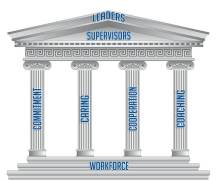Controlling the Climate of Safety Culture
Commitment, caring, cooperation, and coaching can all be observed. If employees do not see progress in these four areas, the safety culture will never grow toward excellence.
What is the safety climate in your organization, and what are you controlling or being controlled by? Perceptions are byproducts of experience. Behaviors are byproducts of influences. Stories told throughout the organization are byproducts of both.
Safety cultures are byproducts of the safety climate and safety chemistry, as described in the July 2014 OH&S article, Evolving Your Safety Culture: Elements That Matter Most. This article will focus on four critical areas of the safety climate company leaders must control to allow the safety culture to evolve to provide its greatest value. As introduced in the 2013 book, STEPS to Safety Culture ExcellenceSM, "For now, suffice it to say that management is not the only influence on safety culture and therefore not the only starting place when beginning to shape or reshape the safety culture. Any time the goals of management and the goals of safety are not in alignment, safety will be a sub-culture and not the overall organizational culture." The climate within the organization will either encourage or suppress the growth toward excellence in a culture. Like growing a plant, the culture will need the right atmosphere to grow to its fullest potential. What is the atmosphere in your organization?
To facilitate growth, one must be aware of what to control and influence. The figure below outlines the three most common levels within an organization that form the foundation and roof of a structure, (Leaders, Supervisors, and the Workforce). Connecting these levels are the four pillars labeled Commitment, Caring, Cooperation, and Coaching.

A practical and highly insightful exercise to measure your safety climate maturity is to lead a group discussion (e.g., leadership team, safety committee, representation from the many levels and departments) on these four pillars to determine the average perceived scores (1-10) and then discuss and understand what could be addressed to enhance them. These conversations identify the precise actions that need to be taken and should ultimately lead to influencing the three- to five-year safety excellence strategy, prioritizing what and how to improve the safety climate of the company culture.
- Commitment: Commitment for safety excellence exists at all levels of the organization. We never accept any level of "good enough" less than excellent because we know this is a journey. Commitment is observable in both words and actions and they (words/actions) support, rather than conflict with, one another. How would you rate this in your organization and why?
- Caring: It is clear achieving safety excellence is more to benefit the employee on and off the job than numbers, finance, or company image? Safety conversations focus more on people than anything else and it is clear, regardless of level, we care about each other. How would you rate this in your organization and why?
- Cooperation: The safety mindset has graduated from getting people to comply (i.e., follow the rules) to thinking before acting and being more proactive than reactive. Ideas are listened to, prioritized, and acted upon. There is confidence we are all working together as a team. We are all involved in efforts to achieve safety excellence. How would you rate this in your organization and why?
- Coaching: We focus more on coaching for performance than managing for compliance. Our efforts help each other improve, including the language we use and steps we take. Performance discussions are one-on-one, occur frequently, and are viewed as positive. Discipline isn’t ignored; it is just recognized as a tool of last resort. How would you rate this in your organization and why?
Climate can be felt by those within and even those visiting the organization, and commitment, caring, cooperation and coaching can all be observed. If employees do not see progress in these four areas, the safety culture will never grow toward excellence. For maximum insight and effectiveness in improvement solutions, involve a mixture of internal stakeholders representing the areas within your company culture and discuss where you are right now and, from their point of view, what experiences would increase the scores. Often, the answers to how to improve and evolve culture are within the company, and all you need to do is ask the right questions, take action, and validate (from the employee's point of view) whether you are making a difference and adding value.
To receive a facilitators guide to help you lead these discussions within your organization, contact the author at [email protected] and mention safety climate and chemistry facilitators guide.
This article originally appeared in the April 2016 issue of Occupational Health & Safety.
About the Author
Shawn M. Galloway is the president of ProAct Safety and co-author of several best-selling books. As a consultant, advisor, and keynote speaker, he has helped hundreds of organizations within every major industry to improve safety strategy, culture, leadership, and engagement. He is also the host of the acclaimed weekly podcast series Safety Culture Excellence®. He can be reached at 936-273-8700 or [email protected].